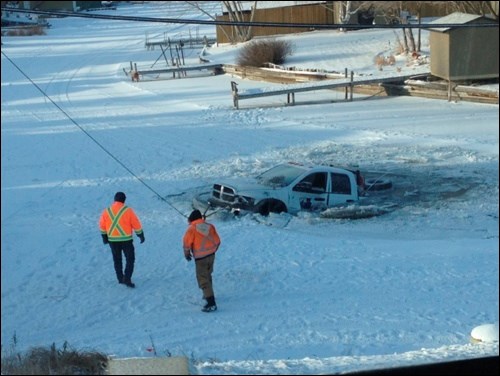The recent cold snap notwithstanding, this winter has been an unseasonably warm one for the Battlefords, with the community losing much of its snow over the last few weeks of above-zero weather.
It has not, however, adversely affected ice fishing in the local area. According to Meota mayor John McDonald, the number of shacks on the lake has, if anything, increased over last year, as has the number of skaters. The ice is believed to be mostly 20 inches thick off the shore at Meota. The increased number of shacks likely has little to do with fishing, which has been sporadic this winter, and more to do with the lack of snow. Because there is so little snow on the lake, there are far fewer snowmobilers and it is far easier to set up an ice fishing shack.
Nevertheless, the Saskatchewan Wildlife Federation advises anyone venturing out on winter ice to be cautious. Aeration projects, which circulate fresh air into small, shallow fish-bearing water bodies vulnerable to winterkill, can often create thin ice or open water. Aeration projects are presently located all over Saskatchewan. Listed alphabetically, Bell pond, Buffalo Pound pond, Ceylon Reservoir, Clearwater Lake, Condie Reservoir, Eagle Creek Pond, From Lake, Lady Lake, Melville Reservoir, Picnic Lake, Redberry Pond, Scott Reservoir, Steistol Lake, Struthers Lake Waldheim Pond, Wilson Lake and Wynyard Reservoir all have aeration projects.
It is important to keep the following in mind to keep safe around ice:
ice strength should never be judged by appearance alone;
ice thickness is seldom uniform throughout a water body and can sometimes vary from safe to unsafe within a metre;
changing temperatures can cause thermal cracks and pressure ridges, which are indicators of unsafe ice;
slush indicates that ice is eroding from above and below;
large, deep lakes take longer to freeze and are slower to melt than smaller lakes;
currents in a river or creek make ice approximately 15 per cent weaker than lake ice; and
heavy snowfall in some areas of the province can reduce the bearing capacity of the ice. The weight of the snow often causes slush and/or flooding. Snow also acts as an insulator, which slows the freezing process.




